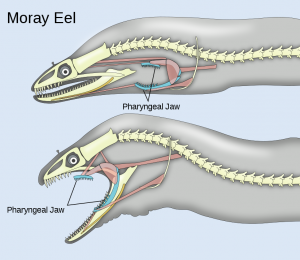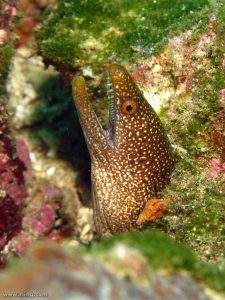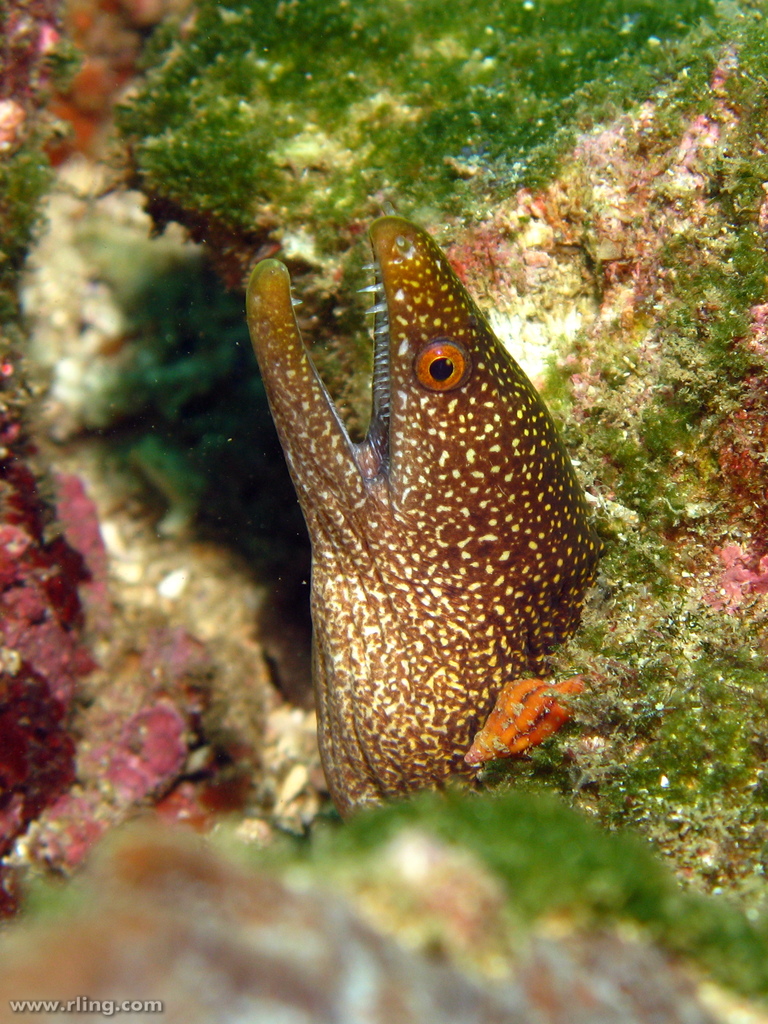Source: Rita S. Mehta and Kyle Donohoe. “Snowflake morays, Echidna nebulosa, exhibit similar feeding kinematics in terrestrial and aquatic treatments.” Journal of Experimental Biology 244, no. 11 (2021). https://doi.org/10.1242/jeb.234047.
What’s more terrifying than one set of toothy jaws on a long, slimy fish? Two sets. The snowflake moray eel—and most bony fish—have a second, smaller set of jaws located behind the pharynx in their throats. This set, called pharyngeal jaws, grinds and processes food and helps push food from the mouth to the esophagus. According to researchers at the University of California, Santa Cruz, the pharyngeal jaws of the snowflake moray eel (Echidna nebulosa) also allow the elongated fish do something most other fish can’t: swallow prey on land.
Most fish require water to eat; when they open their mouths, the negative pressure created within their bodies suctions prey toward their pharyngeal jaws and into their gullet. Dr. Rita Mehta and co-author Kyle Donohoe of UCSC have shown that the snowflake moray eel’s pharyngeal jaws work on land, in the absence of water. The results of their study were published in Journal of Experimental Biology in June.

Unlike those of other bony fish, the pharyngeal jaws of moray eels are secured to long muscles connected to its skull that enable the secondary jaw to extend out of the throat and into the oral cavity of the eel. In 2007, Mehta and her team at the University of California, Davis showed, using high-speed video, that the eel first grasps prey in its oral jaws to hold it in place while the fanged pharyngeal jaws emerge and pull the prey into the throat. This alien-like process enables the eel to consume larger food than most other bony fish.
According to Mehta’s current research, the remarkable mobility of the eel’s pharyngeal jaws is also what confers their unique ability to snag lunch on land. The elongated muscles that attach the jaw to the skull provide the power needed to move prey to the esophagus without negative pressure from water. The extra mobility also makes for a creepy scene as prey is pulled deep into the throat of the eel while its mouth gapes, unmoving (see video by Rita Mehta and Kyle Donohoe, https://doi.org/10.1242/jeb.234047.).
The Taming of the Eel

Snowflake moray eels are widely distributed throughout the Indian and Pacific Oceans. Coral reefs and rocky shores are their ideal habitat, but the eels also wander into deeper waters of up to thirty meters. Snowflake morays are commonly kept as aquarium pets, and just as they are adept at worming onto shore from the sea, so too are they experts at escaping aquariums by nosing the lids off tanks. The eel is a top predator in the wild, consuming hard-shelled crustaceans like crab and shrimp, but also preying on larger animals like octopus and squid. Snowflakes have historically been observed wriggling onto land to snatch unsuspecting crabs, but until now, scientists did not know if they could consume their food entirely out of water.
To prove that eels could make munching excursions on land and to analyze differences between their eating habits on land and underwater, the UCSC team trained seven snowflake morays to undulate onto a ramp and fully consume bits of food before retreating back to the water. How does one train an eel? Undergraduate volunteers coaxed the eels onto the ramp with fresh pieces of squid or octopus held in forceps. Once the eel grasped onto the prey, the trainer used the forceps to pull the eel farther up the ramp where more food was located, but the eels often wanted to haul their prey back to the water before swallowing it. Eventually, however, the animals learned to independently grasp the prey and swallow it with their pharyngeal jaws while on the ramp.
The group videotaped the eels eating underwater and on land and compared their movements using statistical methods. They were surprised to find that the eels’ movements and overall feeding time were similar for both terrestrial and aquatic environments, showing just how efficiently the pharyngeal jaws work out water.

A Competitive Advantage
As human impacts and climate change continue to degrade the world’s oceans, the ability of marine animals to access food from a variety of ecosystems may be life saving. Being able to get their meals from the land and the water makes snowflake morays more resilient than fish that can only feed underwater.
The current study sheds light on previously unseen behavior in moray eels and offers clues as to how it came to be a top predator in the marine ecosystem. Despite its limbless form, the snowflake moray eel has evolved a competitive advantage over other ocean predators with its highly mobile pharyngeal jaws and ability to consume food from terrestrial niches. Mehta continues to study the feeding habits and morphology of elongated fish and limbless creatures because understanding how these seemingly disadvantaged animals catch and manipulate prey gives scientists insights into why these body structures evolved and what advantages they may confer.
I am a student of the MA in Science Writing program at Johns Hopkins University. Environmental science, human health, and agriculture are a few of my writing interests. I love communicating science in a way that incorporates storytelling and that broadens readers’ ideas of what science is, who scientists are, and what it means to do science. When I’m not writing, I can be found playing folk music with friends, riding my bike, or snuggling with my cat.

